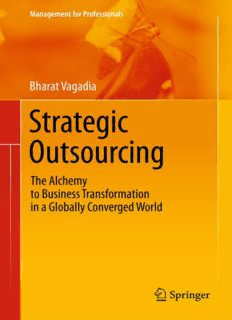
Strategic Outsourcing: The Alchemy to Business Transformation in a Globally Converged World PDF
Preview Strategic Outsourcing: The Alchemy to Business Transformation in a Globally Converged World
Management for Professionals Forfurther volumes: http://www.springer.com/series/10101 . Bharat Vagadia Strategic Outsourcing The Alchemy to Business Transformation in a Globally Converged World Dr.BharatVagadia BramptonGrove53 HA38LELondon UnitedKingdom [email protected] ISBN978-3-642-22208-5 e-ISBN978-3-642-22209-2 DOI10.1007/978-3-642-22209-2 SpringerHeidelbergDordrechtLondonNewYork LibraryofCongressControlNumber:2011938156 # Springer-VerlagBerlinHeidelberg2012 Thisworkissubjecttocopyright.Allrightsarereserved,whetherthewholeorpartofthematerialis concerned,specificallytherightsoftranslation,reprinting,reuseofillustrations,recitation,broadcasting, reproductiononmicrofilmorinanyotherway,andstorageindatabanks.Duplicationofthispublication orpartsthereofispermittedonlyundertheprovisionsoftheGermanCopyrightLawofSeptember9, 1965,initscurrentversion,andpermissionforusemustalwaysbeobtainedfromSpringer.Violationsare liabletoprosecutionundertheGermanCopyrightLaw. Theuseofgeneraldescriptivenames,registerednames,trademarks,etc.inthispublicationdoesnotimply, evenintheabsenceofaspecificstatement,thatsuchnamesareexemptfromtherelevantprotectivelawsand regulationsandthereforefreeforgeneraluse. Printedonacid-freepaper SpringerispartofSpringerScience+BusinessMedia(www.springer.com) I dedicate this book to my late father and grandfather; Khimji Karsan Vagadia and Karsan Parbat Vagadia for showing me the light . Preface This book is for business leaders and managers from both the user and vendor communities who make or implement strategic sourcing decisions. If you lead outsourcing programmes or teams working on outsourcing, or seek to change a functionorprocessthroughtheuseofoutsourcing,havethepowerandauthorityto make decisions, or just feel strongly about the direction of your organisation or outsourcingprogramme,thisbookisforyou. This book bridges academic research and draws on practitioner experience to provide a detailed understanding of how an organisation’s value chain can be re- configuredinordertocreateamoreeffectiveorganisationusingstrategicoutsourcing. Globalisation and in particular convergence are forces affecting most organisa- tions and requires a strategic response by organisations in developed countries. To meetthesechallenges,businessleadershaveturnedtooutsourcingandoffshoringas atooltotransformtheirorganisationalstructures. However, strategic outsourcing and offshoring represent significant changes to businessmodels,andhaveledtosuccessandfailureformanyorganisations. This book provides a roadmap to successful implementation of strategic out- sourcingprogrammes,providingdowntoearthapproachestooutsourcingdecision makingandimplementation,basedonagrassrootsunderstanding. Outsourcingisnotnew;manyorganisationshaveusedoutsourcingsuccessfully to bring about cost reduction, introduce flexibility or access specialist resources. However, not many have managed to use outsourcing in a strategic context. The bookexamineshowstrategicoutsourcingcanhelptransformorganisationalbusiness models,structuresandmindsets. Outsourcingcanbeaveryriskystrategy,ifnotmanagedadequately.Historically the success rate has not been encouraging, with only 40–60% of initiatives being deemed successful. Failure of the outsourcing programme not only affects those processes or functions being transitioned, but also those interdependent elements, touchedbyorassociatedwithsuchactivities.Thefailureofsuchaprogrammecan have longer term consequences for the competitive advantage of the firm and its reputationinthemarket. vii viii Preface Managing these risks, whilst ensuring the rewards sought from outsourcing are delivered, requires a combination of strong legal contracts and a relationship with theserviceproviderbasedonhighlevelsoftrust.Italsorequirestheorganisationto thoroughly understand its own capabilities to manage outsourcing and the impact thismayhaveonitslongertermstrategy. Thisbooktakesthereaderonajourneythroughits15chapters:fromunderstand- ing the drivers for change as a result of globalisation and convergence and their impactonorganisationalstrategies;toexamininghowoutsourcingcantransformthe various processes and functions of an organisation; to the impact outsourcing is havingonvariousindustryverticalsectors. The book then examines the role of the three “R’s” – Risks, Rewards and Relationships, in understanding the scope for the use of, and management of strategicoutsourcing. Awholechapteristhenfocusedontheoutsourcingdecisionmakingprocess,for this is the most important management activity in developing and subsequently managing a programme which delivers. Having understood the decision making process for strategic outsourcing, the focus turns to transition management and governance, and how, what is the most difficult phase of an outsourcing programme,canbemanagedsmoothly. Atthispoint,insightsdrawnfromacademicresearchareprovidedtocomplement thepractitionerexperience.Throughtheseinsights,thebookproceedstoexplainhow risks can be minimised through a combination of formal controls and informal relational exchanges. The whole concept of relational governance is explored in detailwithtwocasestudiesprovidinginsightsintotheclientandvendorperspective. Achapterisdedicatedtothereviewofoffshoredestinations,detailingcriteriafor theevaluationofdestinationsandanalysingtherelativemeritsofoutsourcingwithin morethan35countriesacrossAsia,Americas,EuropeandMENA. The issue of managing culture, especially when dealing with offshore destina- tionsisthenconsidered,with insightsintohowculturaldifferencesmanifestthem- selveswithintherelationshipandhowthesecanbemanaged. The concluding chapter details the eights foundations of successful strategic outsourcingimplementation,whichwhencombinedwithstrategicdecisionmaking knowledge, guarantees that organisations embarking on the strategic outsourcing journeywillderivethetransformationalbenefitstheyseek. Eachchapterincludesanabstractatthebeginningandatake-awayattheendof thechapter,whichserveasusefulreferencechecklistsforpractitioners. Iwantyoutostopthinkingofoutsourcingasatacticaltool,butrecognisethatitis a business system that will be increasinglyimportantinthe future, intransforming the organisational monoliths that we see today into the agile market leaders of the future. Strategic outsourcing will become an indispensable business model for progressivebusinessleaders.Thisbookwillshowyouwhyandhow. Contents 1 RoleofStrategicSourcinginaChangingWorld ....................... 1 1.1 EconomicDrivers ...................................................... 1 1.1.1 ChallengingTimesLeadingtoChangingBusiness ModelsandPractice ............................................. 2 1.1.2 ContraryForcesatWork ........................................ 2 1.1.3 AllEyesonCost ................................................ 2 1.1.4 AllAboard ...................................................... 3 1.1.5 MixedFortunesfortheOutsourcingIndustry .................. 4 1.1.6 ChangingCommercialModels ................................. 5 1.1.7 GettingitRight ................................................. 5 1.2 TakeAways ............................................................ 6 2 GlobalisationandConvergence:Drivers andStrategicOutsourcing ................................................ 7 2.1 Introduction ............................................................ 7 2.2 ConvergentWorld ...................................................... 8 2.3 RaisingBarrierstoGlobalisationandConvergence .................. 10 2.4 AdaptingBusinessestoCompeteonaGlobalLevel ................. 11 2.5 ACaseinPoint:TheRiseofIndia ................................... 16 2.6 TakeAways ........................................................... 19 3 SocialandPhilosophicalConsiderationsofOutsourcing ............. 21 3.1 Introduction ........................................................... 21 3.2 EconomicConsequences .............................................. 22 3.3 SocialConsequences .................................................. 23 3.4 SeparatingtheSpinfromReality ..................................... 24 3.5 PolicyImplications .................................................... 24 3.6 TakeAways ........................................................... 25 References ................................................................. 25 ix
Description: